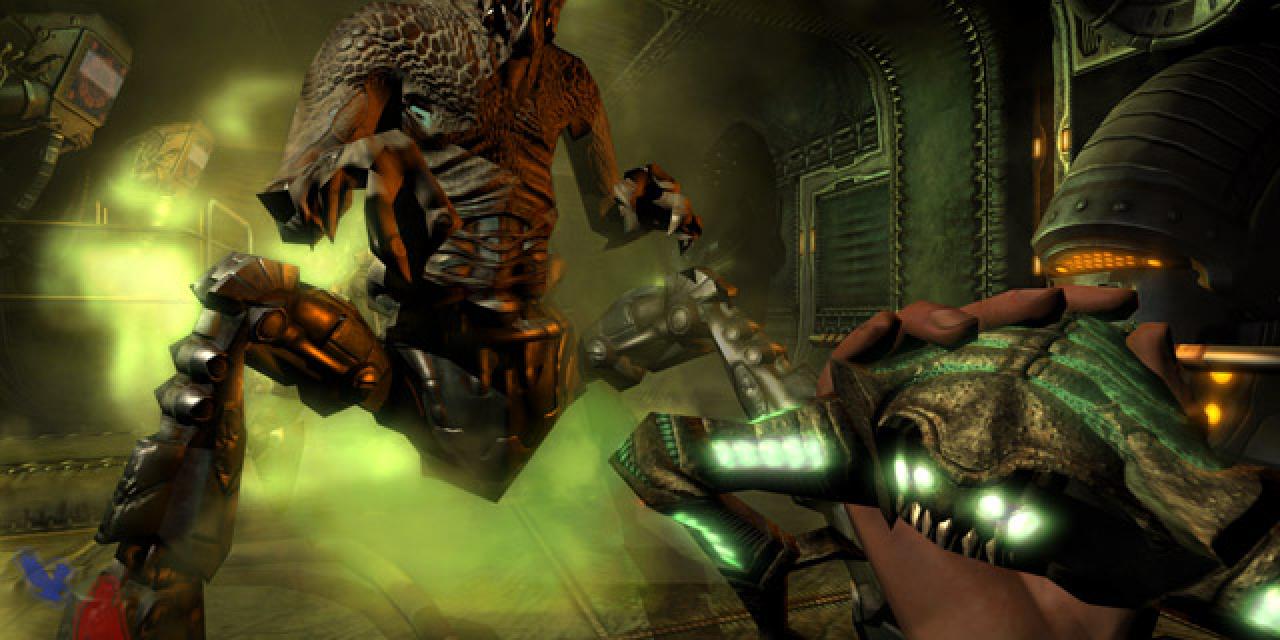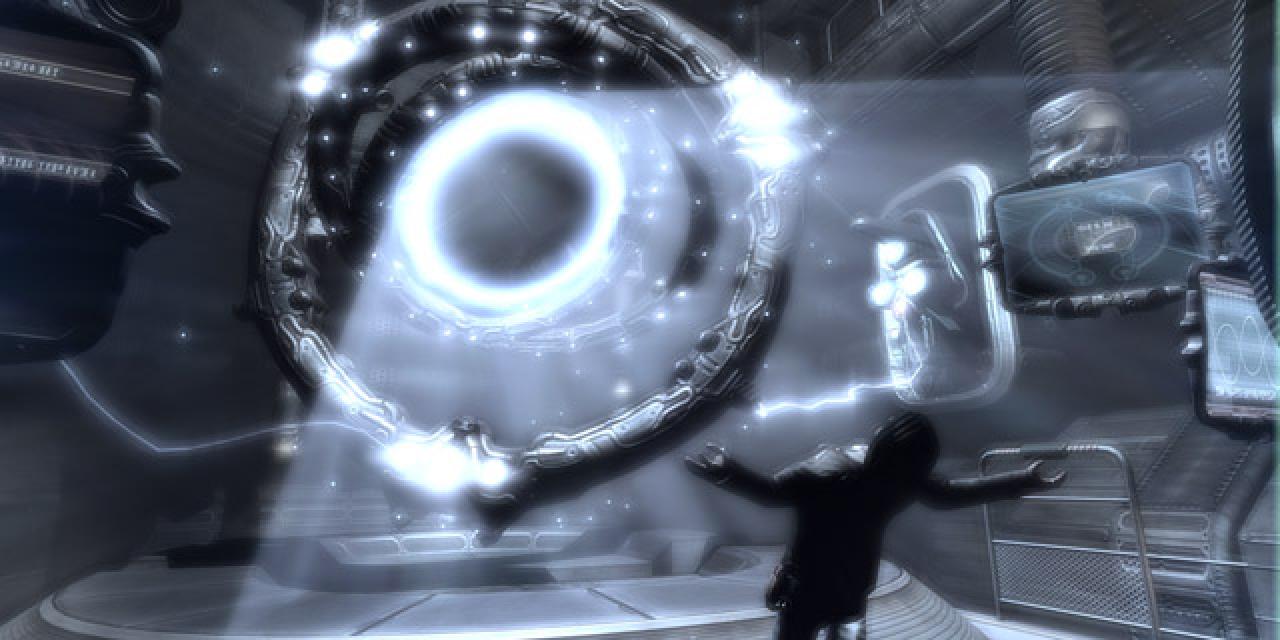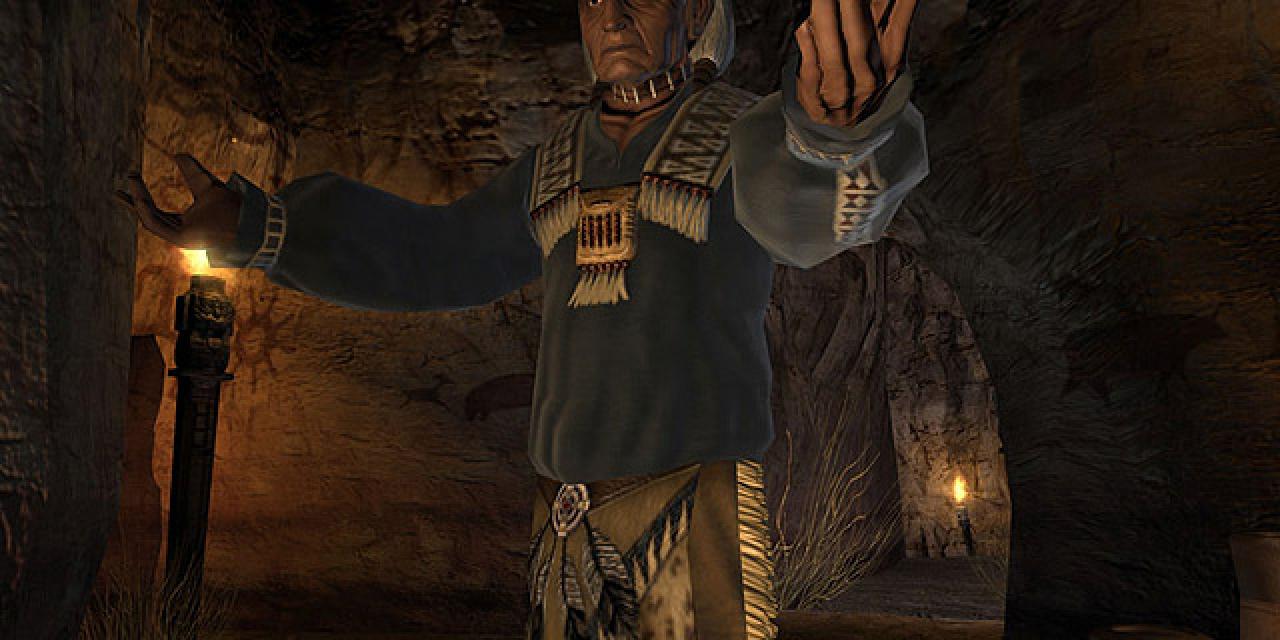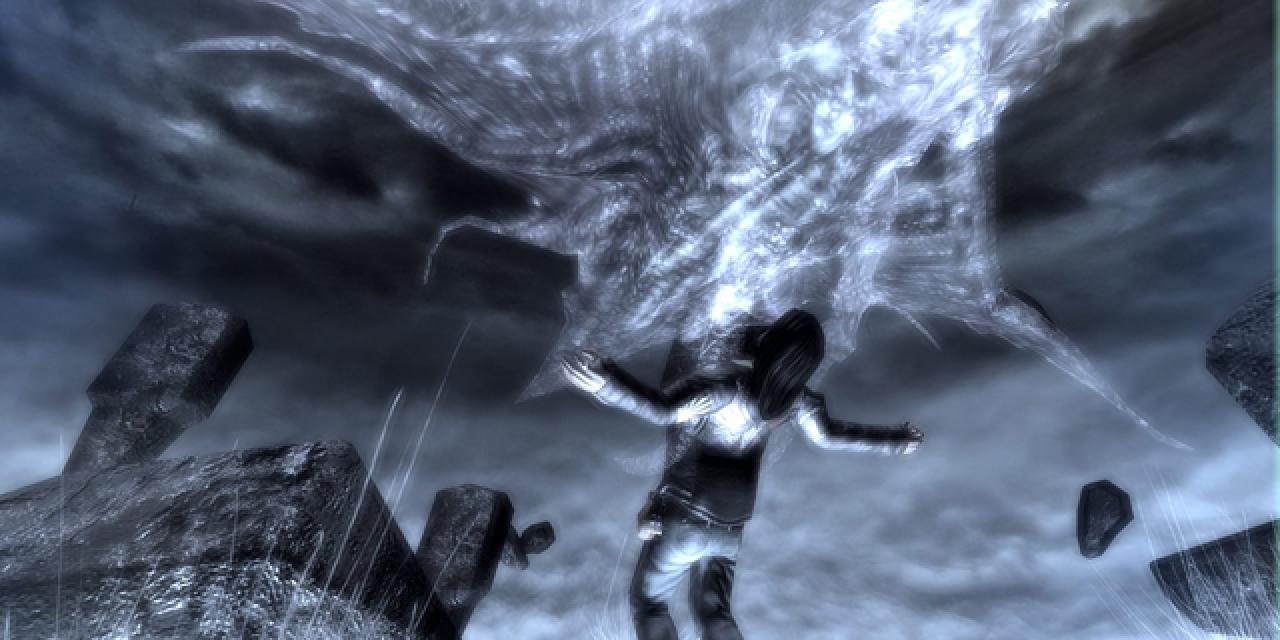























Find out all you need to know about this summer's most anticipated offering, Prey. Join us as we investigate the past, present and future of Tommy Tawodi, formerly known as Talon Brave, the reluctant Cherokee whose destiny it is to save our world.
Anyone walking outside the LA venue of E3 2005 would have little difficulty in picking up the buzz from visitors regarding the exhibition showstopper; it was Prey, the new game from Human Head and 3D Realms. That information however, is inaccurate as Prey may be a lot of things but it's definitely not new. Had the same person been outside the E3 1998 venue in Atlanta, the same buzz could have been heard. Gamers exiting the show would have immediate spasms of joy at the mention of 16-bit Radiosity and portal technology and would have sworn eternal allegiance to 3D Realms for making such high-tech dream games as Prey and Duke Nukem Forever.

It's all about portals, I'll have you know
The premise upon which Prey was conceived has captured the imaginations of millions of movie-goers in the past; a reluctant savior, a regular guy, much like you and me that is asked to save the world and refuses to accept his heroic destiny. Die Hard and John McCLane come to mind when considering the insurmountable odds that the young Cherokee is asked to face.
The story of Prey begins over 10 years ago in 1995 when 3D Realms, hard at work on Duke Nukem 3D, were considering what their next title should be….
Read on to discover how Prey has evolved to the non-stop action title it is today.
1995 was a year when the competition between iD software and 3D Realms was heating up. The two former shareware developers were part of a gaming revival and both companies were trying hard to outdo each other. The fact that iD were working on Quake tipped the balance towards the creation of a dark Sci-Fi game and that was when Prey was born. The team behind the game decided to build a new engine for it from scratch and work begun.
Prey was quickly subtitled You are and You'd Better and the first previews arrived in spring 1996. The future was looking rosy for our young Apache, Talon became Tommy and a Cherokee later on, until Black Monday (8/12/1996) when almost the entire team quit and left the company.

The aliens look familiar…only Sigourney can save us
George Broussard, 3D Realms co-owner reacted instantly be announcing job openings and insisted that Prey development would continue. The team quickly grew in numbers and between 1997 and 1998 progress on the game was rapid. E3 1997 was the first major appearance of the game through a non-interactive demo. The public and critics reacted well to what they saw and innovations such as the destructible environments were greeted with excitement. As Prey was one of the next-generation of 3D games, a 3D accelerator card was a requirement, a move that was considered risky at the time but one which truly placed the title at the cutting edge of video game technology. Prey was quickly dubbed; Quake Killer.
Following the success of E3 1997, a set of decisions were made regarding the details of the game. The aliens were modeled on Larry Niven's concept, as it was developed in his book Ringworld, a book which also served as inspiration for a little known game by Bungie called Halo.
E3 1998 saw the release of a more professional non-interactive demo and the first mentions of a 1998 release were made. Then, on 10/13/1998 George Broussard announced that the two main members of the development team, Paul Schuytema and William Scarboro, had left. The future of the game was again in doubt and most of the Prey team were moved on to Duke Nukem Forever.
There would be little action surrounding Prey until late 2001 when Human Head Studios took over the project. Oddly enough fans and most of the press were not aware that development on Prey was going on until an announcement on 4/15/2005.
For a full history of Prey visit Apogee Games.
Read on to find out what hi-tech wonders you can expect from Prey…
A game that has been in development for so long may, justifiably, cause some concern over its relevance in our HDR, High Definition, surround sound world. Human Head however, has insisted that the game has been completely redesigned and the storyline, even that carrying a few changes, is all that remains from the original 1996 title.
As a sign of how times have changed since Prey was in its infancy, the game now uses the Doom 3 engine, albeit a heavily modified version. One of the first things Human Head revised on the Doom 3 engine were lighting effects, introducing a light-interaction shader system in order to create additional effects. Post-processing shaders were also added offering developers contrast, saturation, tint, blur, and light bloom effects. Bloom is recent innovation which illuminates each pixel according to its position in the environment, achieving a more impressive, yet subtle lighting effect.
Our glow system also gives the artists a controllable per-surface bloom effect that facilitates more convincing bright surfaces, light sources, and particle systems, said Paul McArthur, Human Head Lead Programmer in a recent interview at 1Up. Light will look clean and correct through mesh objects like gratings, for example, he added.

Gravity Boots won't save you here
Human Head also claim to have changed the shader system in order to improve specular effects. As a result Prey compressed normal maps look as good as uncompressed normal maps meaning that the medium-quality settings on Prey will look as good as the Doom 3 high-quality textures while Prey high-quality normal maps can have twice the resolution.
The main weapon in the Prey technology arsenal however, remains the same as it did in those early 1996 days; it's Portal Technology. If you watch the E3 1998 trailer, available by following the download tab above, you will notice how the movie mentions advanced geometry. Even back then Prey claimed to be challenging Euclidean geometry, the geometry of 3D, through its use of the Portal Engine. Portal Technology was the brain child of William Scarboro, the 3D Realms programmer whose brainchild it was. He was the only member of the original not to leave the Prey team in 1997 and he stayed with the project until 1998 when he left 3D Realms under mysterious circumstances. William Scarboro died of an asthma attack in 2002 so Human Head Studios were left to continue his work on Portal Technology (PT). The premise of PT is that the each area in the game is interconnected with other areas and linked through portals creating levels that exist within levels. This however, may not be as simple as it sounds. One way that has been used to describe PT is that what the player can see of his world is what his computer also sees, making entering a room in-game a surreal experience.
As players of FPS games, we're used to mapping out an environment in our heads and having these realistic 3D spaces. We're not expecting spaces to overlap each other or lead back into each other. The most interesting use of portals occurs when you don't realize there's a portal at all, where you're just experiencing an environment that your mind says isn't quite right, says McArthur. It appears that the trick with PT was to manage every in-game feature for portal encounters, for example a bullet fired through a portal has to follow the laws of physics of its new environment and make the transition from one set of laws to another smoothly.
The importance of technology in Prey is reflected on the current minimum specs mentioned by McArthur which are: 2GHz P4*, 384MB RAM, and a DirectX 9 graphics card (*or equivalent)
It is a well known gaming fact that all the technology in the world can't save a game that can't immerse the player in its world, that's why we have tech demos after all.
A lot of the immersive "weight" of Prey is carried by the storyline which relies on the: everyday guy + extraordinary situation => reluctant hero = Commercial Success formula. In the game your hero, plus girlfriend and grandfather, is abducted by an alien ship looking for new life forms to enslave. The ship (a living organism apparently) also needs to recruit supervisors for its slaves and specialists that can oversee its operation. So what can our protagonist do to match the superior technology of the aliens? Tommy is aided throughout the game by his spirit hawk - using Tommy's previous name of Talon -- which can provide wisdom in the form of gameplay hints as well as translation services when alien text is encountered.
Once inside the alien vessel the player notices that the setting is not quite what we have come to expect from an F.P.S. The enemy ship is a living organism that is on the lookout for your presence. As a result your actions within it have to be careful while the look of the ship is more organic than usual. The game will allow players the time to practice moving around in less intense areas so that they become familiar with, the many, intricacies of Prey gameplay.
One interesting fact regarding the single-player experience has to do with the A.I. which Human Head claims will continuously keep an eye on your in-game abilities and will regulate your opponents' skill accordingly; they've called it dynamic difficulty adjustment (DDA) don't you know. In a fight with an alien monster, for example, the A.I. will keep track of the levels of your ammunition and the damage you are taking from and inflicting upon your enemy and will try to give you a fair challenge.

Death is only the beginning
Another interesting aspect of the game is the fact that dying in the alien ship is not the end of your struggle. Death leads you to the spirit realm where you have to fight for your right to return to the game. In your spirit form you have to target health and spirit wraiths in order to replenish your energy and return to the fray, be warned your enemies may figure out what you are doing and may wait for you.
Life after death is not the only way in which Prey follows Native American tradition. Throughout the game Tommy grows closer to his roots and comes to understand his people's tradition. The game also offers areas which the player meets his grandfather that help bring the tradition message home.
MultiPlayer
Although Prey is focused on the single player experience, it will still offer multiplayer modes which seem rather unique and appealing. Prey has fine tuned its multiplayer experience in order to make the most of the unique features it offers.
MP levels have been designed in such a way as to allow players to walk on the ceilings or walls or to use portals to surprise enemies. Although Human Head has kept a lot about its multiplayer under wraps, we have found out that it will offer a deathmatch mode while in some maps vehicular combat will also be possible. Prey will breathe new life into the tired ole deathmatch mode by stirring things up with wall-walking, gravity-inverting, portal-opening mayhem.
Considering the disorientation involved and the learning curve for gamers it is not surprising that multiplayer will only support 8 players per match in both the PC and XBox 360 versions.
There is little doubt that Prey ranks as an AAA title. The game comes with stunning visuals, a researched storyline and filled with innovations and promise. But Prey has been coming soon for 8 years now.
The long wait and the strange 3D Realms effect on games can and does raise a few doubts over the game's delivery date although we have to admit that Prey has never looked as ready as it does at this stage.
Prey's commendable effort to bring innovation to the world of First Person Shooters may be one of its greatest challenges. F.P.S. gamers have settled into a well established routine and are willing to accept change only if it's served in small doses. We are currently experiencing the introduction of physics into games and Prey may be biting off more than it can chew. Portal Technology is pretty hard to communicate so we can imagine that it may trouble some gamers who will also have to, at the same time, worry about gravity switches and wall-walking as well as shooting ghosts when they die. Human Head claims that the transition is intuitive and the learning curve steep, so we will have to wait to see how gamers react to the changes.

Oh what a feeling they're dancing on the…
Another challenge for Prey is to convince gamers that multiplayer for only 8 players is not a backward step. Having grown accustomed to the mayhem of Battlefield 2 it may be hard to do so. We have explained above why it is reasonable for only 8 players to be supported as it takes some head turning to get round the levels but as gamers become familiar with the features of Prey they may begin asking for more out of their multiplayer experience. It is however important to stress that Prey considers itself to be mainly a single player game.
Visually Prey looks stunning but the fact that it will also appear on XBox 360 and that it is using the Doom 3 engine does raise some doubts over its performance on Microsoft's console. Owners of Quake 4 will be familiar with exactly how the Doom 3 engine can hinder gameplay and the fact that the game experienced frame rate issues on X360 is no secret. We are told however that Venom Games, the 2K Games owned developer responsible for the port, is currently hard at work on that issue.
Having commented on our concerns we have to admit that despite all that Prey has the potential to become one of the bigger PC games ever and one of the first next-gen blockbusters. The combination of a captivating storyline, exciting gameplay and splendid visuals can only benefit the game while the myths and spirituality of Native Americans also add to the game's overall impact.
Prey is expected in June 2006 although Human Head is stickling to the traditional 3D Realms when it's done tagline. Stay with MegaGames for more on Prey from E3 2006.
